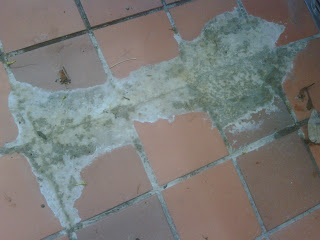By, Mike Marsoun
Ever notice a recently installed exterior stone floor with a black/brown growth on the grout joints. This is where water that has been saturated into the mortar setting bed, and in the heat of the day, escaping through the grout which is the path of least resistance. This water is laced with minerals and insoluble-salts that remain after the water itself has vaporized. These minerals are very hard and not reactive to most acids for removal, and if the floor is Limestone, Travertine, or any other alkaline stone, acids are obviously not an option for cleaning.
(Pictured: extreme case on quarry tile)
 The best way to deal with this common problem is to prevent it before it begins- at installation. Stone that is not gauged (flagstone of sandstone, quartzite, or slate) must be set in a thick bed mortar, dry- pack that is 1 part common cement and four parts sand, (washed river sand). This mortar bed will hold a lot of water which is the source of the above mentioned problem, but this the only way to install stone that is not gauged and get it as flat as possible.
The best way to deal with this common problem is to prevent it before it begins- at installation. Stone that is not gauged (flagstone of sandstone, quartzite, or slate) must be set in a thick bed mortar, dry- pack that is 1 part common cement and four parts sand, (washed river sand). This mortar bed will hold a lot of water which is the source of the above mentioned problem, but this the only way to install stone that is not gauged and get it as flat as possible.
Stone that is gauged however is a different story. On interior installations a dry-pack mortar installation is fine. On an exterior application I have another suggestion that will solve the problem of mineral stained grout. Pre-float the surface for drainage or prepare the slab as needed. Then cover the slab, or pre-floated slab with a waterproof membrane and install the gauged stone over the membrane with a thin-set mortar fortified with acrylic. The edges of the installation, where the slab meets landscaping, should be packed from below with thin-set to prevent water seepage between the slab and stone. This system is also a MUST in oceanfront properties where the soil can be of a much higher mineral salt content and will transmit up through the slab, then up through the stone in the form of efflorescence to cause spalling (flaking) especially in granite.
Preventing moisture from below is also a good idea any time when installing certain types of limestone.
“In composition, the limestone employed by building trades is formed primarily of calcium carbonate (CaCo3) with small amounts of iron oxide that give the stone its warm color…” (Stone World Magazine, Oct. 1992, Pg. 82).
When limestone is constantly exposed to water or water vapors from whatever source, can rust from below and will be seen as an orange stain that cannot be removed as it is throughout the thickness of the stone. Our expert car key locksmith technicians can assist you with anything from new car key cutting to car key duplications that will help get you on your way in no time https://www.247carlocksmiths.com/car-key-replacement-services.
To prevent surface mineral staining make sure landscape irrigation is not over-spraying onto the stone as much as possible. Finnes det et mer elegant og sofistikert casinospill enn blackjack casinonorske.com spille blackjack online? Irrigation water in some parts of Australia is very high in chlorides, nitrates and insoluble-salts, which will cause ugly brown/gray stains. This happens wherever water puddles and then dries up over and over again. This type of discoloration can occur within as little as year of installation.
 The best way to deal with this common problem is to prevent it before it begins- at installation. Stone that is not gauged (flagstone of sandstone, quartzite, or slate) must be set in a thick bed mortar, dry- pack that is 1 part common cement and four parts sand, (washed river sand). This mortar bed will hold a lot of water which is the source of the above mentioned problem, but this the only way to install stone that is not gauged and get it as flat as possible.
The best way to deal with this common problem is to prevent it before it begins- at installation. Stone that is not gauged (flagstone of sandstone, quartzite, or slate) must be set in a thick bed mortar, dry- pack that is 1 part common cement and four parts sand, (washed river sand). This mortar bed will hold a lot of water which is the source of the above mentioned problem, but this the only way to install stone that is not gauged and get it as flat as possible.